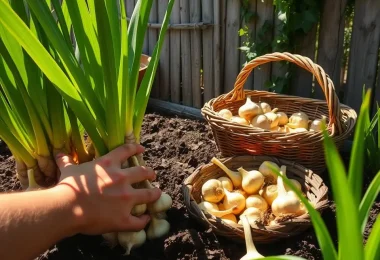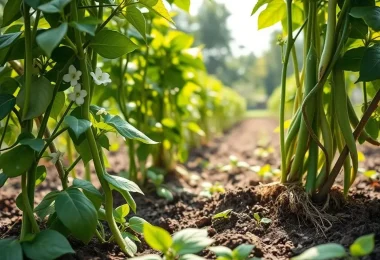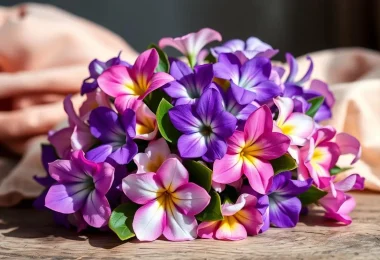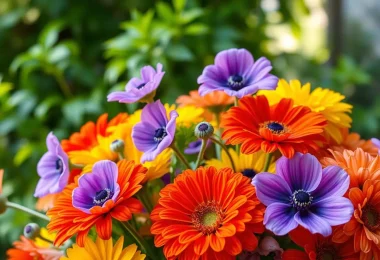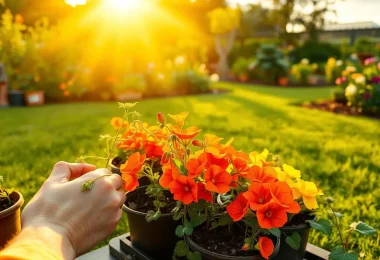Rhododendrons are stunning evergreen shrubs that add vibrant colour and texture to any garden. Whether you’re a seasoned gardener or new to cultivating these botanical beauties, this comprehensive guide will equip you with the essential knowledge. You’ll learn how to successfully plant, grow and maintain healthy, thriving rhododendrons.
We’ll cover all the key steps to help you create a lush, vibrant rhododendron display in your outdoor space. From selecting the right variety to mastering the art of planting and ongoing care, we’ve got you covered.

Key Takeaways
- Rhododendrons are versatile evergreen shrubs that can enhance any garden with their colourful blooms
- Selecting the right rhododendron variety for your climate and soil conditions is crucial for success
- Proper site preparation, planting techniques and ongoing care are essential for healthy, thriving rhododendrons
- Rhododendrons require specific soil, light and moisture requirements to flourish
- Pruning, pest management and winter protection are important maintenance tasks for rhododendrons
Rhododendron: Evergreen Shrubs for Beautiful Gardens
Rhododendrons are versatile, evergreen shrubs that can add a stunning visual element to any garden. These magnificent plants, with their glossy, broad leaves and vibrant blooms, are a beloved choice for gardeners across the United Kingdom.
One of the key features that make rhododendrons so appealing is their evergreen nature. Unlike deciduous shrubs that shed their leaves in the autumn, rhododendrons maintain their lush foliage all year round. This provides a consistent and eye-catching presence in the garden. They are an excellent choice for creating privacy screens, hedges, and backdrops for other flowering plants.
Rhododendrons come in a wide range of sizes, from compact dwarf varieties to towering specimens that can reach up to 6 metres in height. This versatility allows gardeners to incorporate them into a variety of landscape designs. Whether planted as a standalone feature or used to complement other shrubs and perennials, rhododendrons are sure to make a lasting impression.
Beyond their visual appeal, rhododendrons also play an important role in supporting local wildlife. The nectar-rich flowers attract a variety of pollinators, such as bees and butterflies. The dense foliage provides valuable shelter and nesting sites for birds.
“Rhododendrons are the aristocrats of the garden, their regal blooms and evergreen leaves commanding attention wherever they are planted.”
Whether you’re a seasoned gardener or just starting to explore the world of horticulture, rhododendrons are a versatile and rewarding choice. They can transform any outdoor space into a true haven of beauty and tranquillity.
Choosing the Right Rhododendron Variety
Adding a rhododendron to your garden is exciting but can feel overwhelming. There’s a wide range of colours, bloom times, and growth habits. Knowing the differences helps gardeners pick the right one for their space.
Deciduous vs. Evergreen Rhododendrons
Deciduous rhododendrons, like Rhododendron mucronulatum, lose their leaves in autumn. This shows off their branches in winter. Evergreen types, such as Rhododendron catawbiense, keep their leaves all year. They add colour and texture even in cold months.
Colour Variations and Bloom Times
- Rhododendron flowers come in many colours, from soft pastels to bright shades. You can find pink, purple, white, red, yellow, and even bicolour blooms.
- Bloom times vary too. Some, like Rhododendron dauricum, bloom in March. Others, like Rhododendron maximum, bloom in summer.
| Variety | Deciduous/Evergreen | Colour | Bloom Time |
|---|---|---|---|
| Rhododendron mucronulatum | Deciduous | Pink | Early Spring |
| Rhododendron catawbiense | Evergreen | Purple | Late Spring |
| Rhododendron dauricum | Evergreen | Red | Early Spring |
| Rhododendron maximum | Evergreen | White | Mid-Summer |
By thinking about growth habit, colour, and bloom time, gardeners can create a beautiful display. This display will enchant everyone all year round.

“Rhododendrons are the aristocrats of the garden world, commanding attention with their bold, beautiful blooms and evergreen foliage.”
Site Selection for Planting Rhododendrons
Choosing the right spot for rhododendrons is crucial for their success. These evergreen shrubs need specific soil and light to grow well and bloom brightly.
Soil Requirements for Healthy Growth
Rhododendrons love well-drained, acidic soil with a pH of 4.5 to 6.0. They prefer soil that’s rich and holds moisture but doesn’t get waterlogged. Don’t plant them in heavy clay or where water doesn’t drain well, as this can cause root rot.
Ideal Light Conditions
Rhododendrons need partial shade to full sun, depending on the type. Most do best with 4-6 hours of direct sunlight a day. They should also have some protection from the strong afternoon sun. Plant them where they get dappled shade or are protected from the wind to prevent leaf scorch and ensure they grow well.
By considering the soil and light needs of rhododendrons, gardeners can pick the best spot. With the right conditions, these vibrant evergreen shrubs will flourish and add beauty to any garden.

“The key to growing healthy rhododendrons is to mimic their natural habitat as closely as possible.”
Preparing the Planting Area
Before planting your rhododendrons, it’s key to prepare the area well. This step is crucial for healthy plants. They will add colour and lush foliage to your garden for years.
Amending the Soil
Rhododendrons need acidic, well-drained soil rich in organic matter. If your soil is not acidic, you can make it so by adding:
- Peat moss
- Compost
- Pine bark
- Sulphur
Mix these well into the top 12 inches of soil. This will make the perfect soil for your rhododendrons.
Improving Drainage
Rhododendrons don’t like wet, poorly drained soil. If your soil is heavy clay or holds too much water, raise the planting bed. Raise it by 6-12 inches to ensure good root aeration.
| Soil Amendments for Rhododendrons | Benefits |
|---|---|
| Peat Moss | Increases soil acidity and improves moisture retention |
| Compost | Adds organic matter and nutrients to the soil |
| Pine Bark | Enhances drainage and aeration |
| Sulphur | Lowers soil pH to create the acidic conditions rhododendrons prefer |
By preparing the planting area well, you’ll ensure your rhododendrons thrive. You’ll enjoy their vibrant blooms and lush foliage for years.

Step-by-Step Guide to Planting Rhododendrons
Planting rhododendrons needs careful attention for them to flourish in your garden. Follow these steps for a successful planting process.
Proper Planting Depth
When planting rhododendrons, the depth is key. Dig a hole that’s two to three times the width of the root ball. Make it only slightly deeper than the root ball.
The top of the root ball should be a bit above the soil level. This allows for mulch and water to drain properly.
Mulching and Watering Techniques
After planting, spread a 2-4 inch layer of organic mulch around the plant. Use bark chips or pine needles. This keeps the soil moist and stops weeds.
Water the rhododendron well, making sure the soil stays moist but not too wet. Keep watering regularly, especially when it’s dry. This helps the roots grow strong and deep.

“Proper planting and care are essential for rhododendrons to thrive and reward you with their stunning blooms year after year.”
By using these techniques, you’ll give your rhododendrons a great start. Keep an eye on the soil moisture and adjust your watering as needed. This will help the plants stay healthy and vibrant.
Ongoing Care and Maintenance
Looking after your rhododendrons needs regular effort. By sticking to a few key steps, your plants will stay healthy and bloom beautifully every year.
Pruning and Deadheading
Pruning and deadheading are vital for rhododendrons. Prune right after they’ve finished flowering, usually in late spring or early summer. This encourages new growth and shapes the plant, making it look fuller and more appealing.
When you prune, take out any dead, damaged, or crossing branches. Try to make the plant open and well-shaped. Cut just above an outward-facing bud or leaf. Don’t cut into the older, woody parts as it can harm the plant.
Deadheading is also key. It involves removing spent flowers. This helps the plant focus on growing new flowers instead of keeping old ones. Gently remove the faded blooms without harming the leaves around them.
| Pruning | Deadheading |
|---|---|
| Prune after flowering, typically in late spring or early summer Remove dead, damaged, or crossing branches Cut back just above an outward-facing bud or leaf Avoid cutting into older, woody parts of the plant | Remove spent flower blooms regularly Helps direct plant energy into new growth and flower buds Gently pinch or snip off the faded flowers Take care not to damage the surrounding foliage |
By using these pruning and deadheading methods, you can keep your rhododendrons healthy and looking great. This ensures they’ll keep blooming and adding beauty to your garden year after year.
Rhododendron Propagation Methods
Growing rhododendrons can be very rewarding. There are many ways to spread your collection or share with others. We’ll look at the main methods for growing rhododendrons.
Propagation by Cuttings
Stem cuttings are a common way to grow rhododendrons. Here’s how to do it:
- Take 4-6 inch cuttings from new growth, making sure they have 3-4 leaf nodes.
- Remove lower leaves, keeping only the top set.
- Dip the cut end in rooting hormone to help roots grow.
- Plant in a mix of peat moss and perlite, which drains well.
- Keep the soil moist and the cuttings in a shaded, humid spot until they root, which takes 2-3 months.
Propagation by Division
If you have big rhododendron plants, division is a good option. It means splitting the plant into smaller parts. Here’s how:
- In early spring or autumn, carefully dig up the plant.
- Use a sharp spade to split the root ball into two or more parts, making sure each has healthy roots and leaves.
- Plant the new sections in their spots, watering well.
- Watch the new plants closely, giving them extra care until they settle in.
Learning these methods lets you grow more rhododendrons and share them with others.

Common Pests and Diseases
Rhododendrons are tough plants but can still get sick. They can get pests and diseases that harm their health and look. Knowing how to spot and fix these problems is key to a healthy garden.
Identifying and Treating Pest Infestations
Lace bugs are a big problem for rhododendrons. They eat the leaves from underneath, making them look bad. Aphids, spider mites, and caterpillars also harm them by eating leaves and slowing growth.
- Check your rhododendrons for pests and damage.
- Use sprays or oils to kill pests, but read the labels first.
- Help by attracting natural enemies like ladybirds and lacewings.
Preventing Fungal Diseases
Rhododendrons can get fungal diseases like powdery mildew and leaf scorch. These can make leaves wilt and turn colours, and can even kill the plant if not treated.
- Keep air moving by pruning plants that are too close together.
- Water plants at the base to avoid wet leaves, which fungi love.
- Use a fungicide right when you see disease, and follow the directions.
By watching closely and acting fast, you can keep your rhododendrons healthy and beautiful for a long time.
Companion Planting with Rhododendrons
Rhododendrons are loved for their bright flowers and green leaves. They can be paired with other plants to make gardens look amazing. This idea of planting together helps the garden look better and stay healthy.
There are many plants that go well with rhododendrons. Azaleas are a great match because they need the same care and look good together. Pieris shrubs have pretty flowers that stand out against rhododendrons. Adding ferns and hostas around rhododendrons brings a woodland feel.
| Companion Plant | Benefits |
|---|---|
| Azaleas | Similar growing requirements, complementary colours |
| Pieris | Delicate blooms, provide visual contrast |
| Ferns | Shade-loving, add texture and woodland charm |
| Hostas | Thrive in similar conditions, broad leaves complement rhododendron foliage |
When planning a garden with rhododendrons, think about how everything will look together. Where you put plants, the colours, and how they grow are all important. Choosing the right plants can make your rhododendrons look even better and turn your garden into a special place.
“Companion planting with rhododendrons is like painting with a palette of vibrant colours and contrasting textures – the possibilities are endless!”
Landscaping Ideas with Rhododendrons
Rhododendrons are versatile evergreen shrubs that can transform a garden’s landscape. They can create stunning borders or impactful hedges. These vibrant plants offer endless possibilities for garden design. Let’s explore inspiring ways to incorporate rhododendrons into your landscaping vision.
Creating Stunning Borders and Hedges
Rhododendrons are great for garden borders. Their lush foliage and colourful blooms can frame flower beds and pathways. Plant them in a row for a cohesive, eye-catching border that adds depth and structure to your outdoor space.
For a more formal look, shape rhododendrons into carefully pruned hedges. These hedges serve as living walls, providing privacy and definition to your garden.
- Experiment with different rhododendron varieties to achieve a range of colours and bloom times, keeping your borders visually interesting throughout the seasons.
- Ensure proper spacing between plants to allow for their natural growth and prevent overcrowding.
- Regularly prune and maintain rhododendron hedges to keep them looking neat and tidy.
By strategically incorporating rhododendrons into your garden design, you can create stunning focal points. They can define boundaries and elevate the overall aesthetic of your outdoor oasis.
“Rhododendrons are the aristocrats of the garden world, with their stately presence and regal blooms.”
Winter Protection for Rhododendrons
As winter gets closer, it’s key to protect your rhododendrons from the cold. These evergreen shrubs can get damaged by cold, frost, and other winter issues if not shielded. With the right steps, your rhododendrons can make it through winter and keep growing in your garden.
Preparing for Winter
Before the first frost, prepare your rhododendrons for winter:
- Prune dead or damaged leaves to promote new growth in spring.
- Put a layer of mulch around the plant, but not over the crown.
- Water the plants well to keep them moist before the ground freezes.
Providing Winter Protection
When winter starts, you need to protect your rhododendrons from cold and frost:
- Set up a windbreak, like burlap or evergreen boughs, to block harsh winds.
- Use an anti-desiccant spray to stop moisture loss and prevent frost damage.
- Use horticultural fabric or a frost blanket to cover plants in extreme cold.
By taking these steps, your rhododendrons will survive winter and bloom beautifully in spring.
| Winter Protection Measure | Benefits |
|---|---|
| Pruning and Mulching | Encourages healthy growth, insulates roots |
| Windbreak Barrier | Shields plants from harsh winds and cold |
| Anti-desiccant Spray | Prevents moisture loss and frost damage |
| Frost Blanket or Fabric | Provides additional insulation during severe cold |
By following these tips, your rhododendrons will survive winter and flourish in your garden for many years.
Troubleshooting Common Issues
Growing rhododendrons can be rewarding, but gardeners may face problems. Knowing how to tackle these issues helps your plants thrive. They will continue to show off their leaves and flowers beautifully.
Wilting and Discoloured Leaves
Wilting or discoloured leaves can signal several problems. It might be due to too little water, not enough nutrients, or too much sun. Make sure your plants get enough water, especially when it’s dry. Also, use a balanced, slow-release fertiliser made for acid-loving plants.
Bud and Flower Blast
“Bud and flower blast” is a common issue with rhododendrons. It means the buds or flowers won’t open or will wither early. This can happen due to late frosts, drought, or bad pruning. Keep your plants safe from sudden cold and make sure they stay moist to avoid this problem.
Stunted Growth
If your rhododendrons aren’t growing well, it could be because of bad soil, not enough sun, or pests and diseases. Improve the soil with organic matter. Make sure they get at least half a day of direct sunlight. Also, check for pests or diseases on the leaves and flowers.
| Common Issue | Possible Causes | Solutions |
|---|---|---|
| Wilting and Discoloured Leaves | Inadequate moisture Nutrient deficiencies Excessive sunlight exposure | Ensure consistent watering Apply balanced, slow-release fertiliser Provide appropriate shade |
| Bud and Flower Blast | Late spring frosts Drought stress Improper pruning | Protect plants from temperature changes Maintain consistent moisture Prune at the right time |
| Stunted Growth | Poor soil conditions Inadequate sunlight Pests and diseases | Amend soil with organic matter Ensure at least a half-day of direct sunlight Inspect for and treat pests and diseases |
By tackling these common problems and troubleshooting, you can keep your rhododendron plants healthy. They will bring joy to your garden for many years.
“The secret of growing good rhododendrons is to give them what they want, not what you want to give them.”
– Lois Stevens, renowned rhododendron expert
Where to Buy Quality Rhododendron Plants
Finding top-quality rhododendron plants is key for a beautiful garden. In the UK, gardeners can find them in local nurseries and online shops. Local garden centres and rhododendron nurseries have a wide range of healthy plants. You can see them in person and choose the right ones for your garden.
Online shopping is also an option. Many online plant shops specialise in rhododendrons. They offer lots of species and give advice on how to care for them. Always check the seller’s reputation, read reviews, and ask about delivery and plant quality before buying.
It doesn’t matter if you buy from a local nursery or online. What’s important is buying from a trusted source. This way, you’ll have a good chance of growing a beautiful rhododendron garden. It will bring you joy with its colourful flowers and green leaves for many years.
FAQ
What is the best time of year to plant rhododendrons?
Spring or autumn are the best times to plant rhododendrons. Spring planting lets roots grow during the growing season. Autumn planting helps the plant get ready for winter.
How much sunlight do rhododendrons need?
Rhododendrons like partial shade to dappled sunlight. They do well with 4-6 hours of direct sunlight a day. Too much sunlight can harm the leaves and plant.
What type of soil do rhododendrons require?
Rhododendrons need well-drained, acidic soil with a pH of 4.5 to 6.0. A rich, organic soil with lots of humus is best. Adding compost or peat moss can improve the soil.
How often should rhododendrons be watered?
Rhododendrons need consistent moisture, especially in the growing season. Water them deeply once or twice a week. Make sure the soil is moist but not too wet.
When is the best time to prune rhododendrons?
Prune rhododendrons in late spring or early summer, after they’ve finished flowering. This helps them recover for the next growing season. Avoid pruning in winter to protect the plant from cold.
How can I encourage more blooms on my rhododendrons?
For more blooms, ensure your rhododendrons get enough sunlight, water, and nutrients. Use acidic, slow-release fertiliser regularly. Deadheading spent blooms also helps.
Are rhododendrons deer-resistant?
Yes, rhododendrons are deer-resistant due to andromedotoxin. But deer might still eat them, especially when food is scarce. Use barriers or deer-repellent sprays to keep deer away.
How can I propagate rhododendrons?
You can propagate rhododendrons through stem cuttings, dividing, or layering. Take softwood or semi-hardwood cuttings in spring or summer. Dividing the root system in spring or autumn also works.
What are some common pests and diseases that affect rhododendrons?
Rhododendrons face pests like aphids, lace bugs, and thrips, and diseases like Phytophthora root rot and leaf scorch. Good soil and avoiding moisture stress can prevent many issues. Early detection and treatment are crucial for healthy plants.



